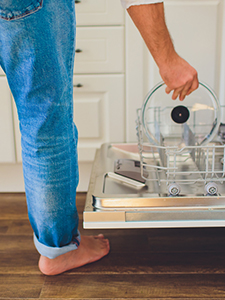POST TAGS
Blog posted On February 26, 2020

Cleaning your home is always a good idea, especially in the midst of cold and flu season. Germs are just about everywhere, not just in the places you expect like door handles. For example—did you know that the kitchen is the germiest part of your home? Yes, even surpassing your bathroom!
Keep in mind, there are germs in more places than just your kitchen and bathroom. When you’re cleaning your home, don’t overlook these germ hotspots.
Shouldn’t the thing washing your clothes and towels be clean too? As much as we hate to admit it, washing machines are pretty gross, especially if you tend to wash your clothes in colder temperatures. In order to kill bacteria in your clothes, you must launder them at a temperature of 140 degrees Fahrenheit. Anything colder than that, and you’re practically creating a breeding ground for cross-contamination in an appliance meant for cleaning! Another part of the washing machine susceptible to germs is the detergent drawer. This little drawer is a hidden trap for moisture and mold, no matter how much detergent goes through it.
In order to prevent mold and bacteria buildup, leave the washing machine door and the detergent drawer open to air out for several hours after washing. To clean any existing mold, use an even mixture of white vinegar and baking soda to wipe down affected surfaces.
Yes, something so small can easily become so filthy. Because you use your toothbrush to clean your mouth, you expect it to be clean, right? Unfortunately, your toothbrush is the perfect place for bacteria to hide, and a dirty toothbrush holder will multiply the germs.
According to the National Sanitation Foundation, your toothbrush holder is the third-dirtiest item in your home. In order to keep it clean, store it as far away from the toilet as possible, and wash your hands before brushing your teeth. If your toothbrush holder is dishwasher safe, then run it through there to keep it clean. Otherwise, handwashing it will do the trick.
What kind of germs are hiding in your rugs and carpets? Chances are, dirt and dander are lurking around in your carpets, especially if you have children or pets. If you live in a humid climate, your rugs and carpets may even have mold! Once microscopic spores find a moist, organic surface, they’ll settle down and start to grow—leading to a serious mold problem. On top of those issues, dust mites are another problem that will affect unclean carpets. While these mites aren’t parasitic and won’t bite, their skin shedding, fecal matter, and secretions are the allergy-causing components of household dust, Jack White, vice president of technical services for Rainbow International told Realtor.com.
One of the most obvious ways to clean your rugs and carpets is to vacuum. However, White recommends getting professional rug and carpet cleanings from time to time. These cleanings help to remove dead skin cells, lint, hair, dead insects, etc.—all of which are food sources for carpet beetles and dust mites. These cleanings can also eliminate the bacteria, viruses, and mold that a simple vacuuming job will leave behind.
Just like your washing machine, you expect your dishwasher to be clean. It is a cleaning appliance, after all. However, a dishwasher is one of the biggest culprits for potential mold growth. Because this appliance has a warm and damp environment, mold spores can easily thrive in your dishwasher, especially if there are food particles left behind from your last wash cycle!
To avoid mold growth, use a paper towel to remove bits of food that get left behind after each dishwashing cycle. Once a month, deep clean your dishwasher by running a cycle with a dishwasher cleaning tablet. Keep in mind that these tablets are not the same as detergent tablets, so check to make sure your dishwasher cleaner can be used in the same cycle as dishes and detergent.
When was the last time you cleaned your coffee maker? It turns out, you should be cleaning it every day! Coffee machines use both heat and water in a small, confined space—making it a breeding ground for bacteria and mold.
In May of 2015, Loyola University examined several Chicago families’ coffee makers and found bacteria such as staphylococcus, streptococcus, bacillus cereus, and even e-coli.
In order to clean a typical coffee maker, remove the pot and detachable water reservoir and wash them thoroughly in the sink.
If you have a single-cup coffee maker, flush the machine with vinegar to clean it regularly. Also, be sure to use filtered water, change the water after each use, and allow the pieces to dry completely after cleaning them.
While cleaning may not be everyone’s favorite activity, it can benefit you and everyone in your home. Many of us tend to focus on popular surfaces, such as countertops and tables, but ignoring germ hotspots can cause you or a family member to become sick. Along with cleaning the items listed above, make sure you replace your cleaning supplies (such as sponges and brushes) regularly so that your cleaning efforts will kill bacteria, not spread it.
Sources: Realtor, National Sanitation Foundation, CBS